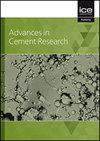评估作为硅酸盐水泥生产新型可持续资源的元片石
IF 1.3
4区 工程技术
Q3 CONSTRUCTION & BUILDING TECHNOLOGY
引用次数: 0
摘要
在这项研究中,首次调查了在制备水泥生料混合物时使用元冲灰岩替代砂粘土的情况。虽然许多国家,特别是土耳其和美国的元页岩储量很高,但在水泥生产中使用元页岩的实验研究还不够多,其优越的技术特性仍有待证明。为了通过研究元片麻岩的矿物和化学特性来生产最高质量的波特兰水泥熟料,我们制备了两种不同的生料样品,一种以传统水泥粘土为基准样品((PC)Ref),另一种以元片麻岩为基准样品((PC)MSC)。根据在 1200、1300、1350、1400 和 1450 °C 下烧结后样品中未反应的石灰含量,评估了两种生料混合物对燃烧性测试和反应性的影响。在 1450 °C 煅烧后,((PC)MSC)表现出良好的烧结性能,游离石灰含量小于 1%(按重量计)。通过偏光光学显微镜检测硅酸盐相晶体的孔隙率、分布、晶粒结构以及元硬石膏相(C3S、C2S、C3A 和 C4AF)的等效晶体直径和数量,结果表明它们适合生产 PC。点计数法、博格模型计算和 X 射线衍射图均证实了这一结果。水泥砂浆的水化产物是在 2 天、7 天和 28 天时通过 SEM 和 EDX 分析测定的。此外,((PC) MSC)和((PC) Ref)砂浆在 28 天固化后的抗压强度测试结果介于 57 和 55.5 兆帕之间,生产的水泥被归类为 CEM I 42.5R。本文章由计算机程序翻译,如有差异,请以英文原文为准。
Assessment of meta-schist as a novel sustainable resource for Portland cement manufacturing
In this study, the use of meta-schist as an alternative to sand-clay in preparing cement raw mixtures was investigated for the first time. Although there are high meta-schist reserves in many countries, especially in Turkey and America, there have not been enough experimental studies for their use in cement production, and their superior technical features still need to be demonstrated. To produce the highest quality Portland cement clinker by examining the mineral and chemical properties of meta-schists, two different raw meal samples were prepared, utilizing conventional cement clay as a baseline sample ((PC) Ref) and the other with meta-schist ((PC) MSC). The effects of both raw mixtures on burnability tests and reactivity were evaluated based on the unreacted lime content in samples after sintered at 1200, 1300, 1350, 1400, and 1450 °C. As a result of firing at 1450 °C, ((PC) MSC) exhibited good sintering properties by showing less than 1% free lime by weight. The porosity amount, distribution, grain structure of silicate phase crystals and equivalent crystal diameters and amounts of meta-schist clinker phases (C3S, C2S, C3A and C4AF) examined by polarizing optical microscope showed that they are suitable for the production of PC. The point counting method, Bogue model calculations, and XRD patterns have confirmed this result. The hydration products of the cement mortars were determined by SEM and EDX analysis at 2, 7, and 28 days. In addition, the compressive strength test results of ((PC) MSC) and ((PC) Ref) mortars after 28 days of curing ranged between 57 and 55,5 MPa, and the produced cement was classified as CEM I 42,5R.
求助全文
通过发布文献求助,成功后即可免费获取论文全文。
去求助
来源期刊

Advances in Cement Research
工程技术-材料科学:综合
CiteScore
3.70
自引率
5.00%
发文量
56
审稿时长
3.2 months
期刊介绍:
Advances in Cement Research highlights the scientific ideas and innovations within the cutting-edge cement manufacture industry. It is a global journal with a scope encompassing cement manufacture and materials, properties and durability of cementitious materials and systems, hydration, interaction of cement with other materials, analysis and testing, special cements and applications.
 求助内容:
求助内容: 应助结果提醒方式:
应助结果提醒方式:


